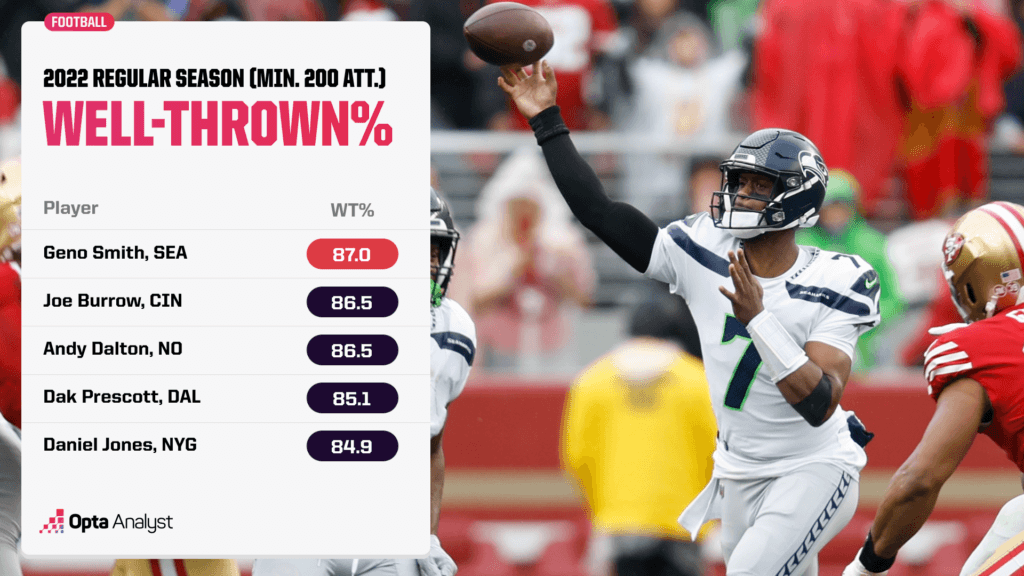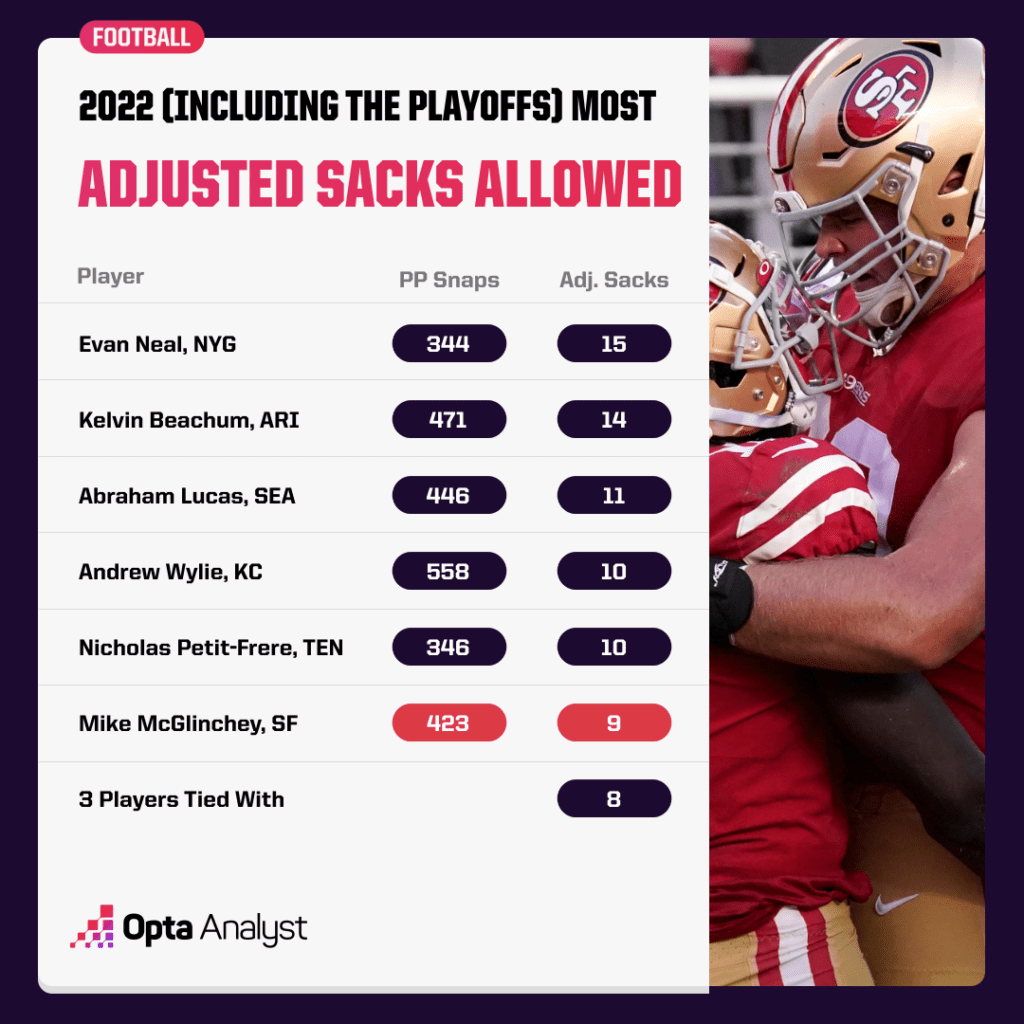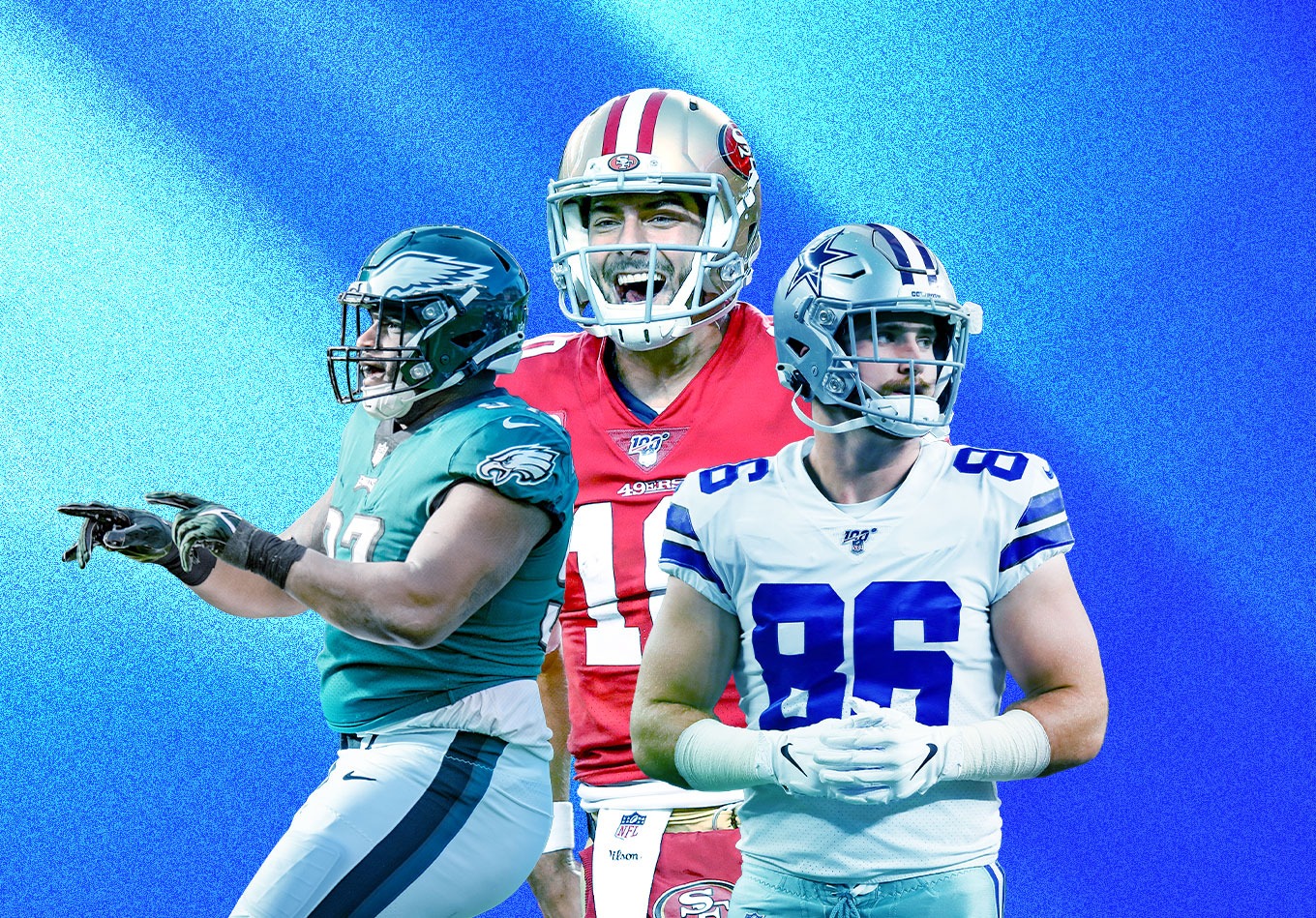One of the most oft-repeated phrases is that there is no offseason for NFL teams.
It bears repeating because the league consistently validates it year after year, with the ‘offseason’ serving as an ever-increasing hive of activity as teams reconfigure their rosters through free agency and the NFL Draft in the hopes of putting together a winner.
That activity was supposed to kick into high gear for 2023 NFL free agents on March 13 when the ‘negotiating period’ opened ahead of the new league year.
But the league is already ahead of schedule in that sense, as Tuesday’s franchise tag deadline was one teeming with headlines.
Quarterbacks Derek Carr, Geno Smith and Daniel Jones were all signed to lucrative contracts, the latter pair remaining with the Seattle Seahawks and New York Giants, respectively.
The Giants also franchise-tagged Saquon Barkley and the Baltimore Ravens did the same with 2019 MVP Lamar Jackson, though their decision to place the non-exclusive tag on the star quarterback has only increased the doubt about his long-term future.
So much has already been resolved, or not quite resolved in the case of Jackson, yet there are still a plethora of star names at positions on both sides of the ball who will be free to talk to teams on Monday.
The news will likely come thick and fast. With that in mind, let’s look at the key storylines to follow in free agency through the prism of our advanced data.
Brissett and Jimmy G’s Value
The first major domino in the quarterback market fell on Monday when Carr was signed to a four-year, $150-million deal by the New Orleans Saints.
That deal was followed in relatively short order by another, with the Seahawks retaining Smith on a three-year contract worth $105 million, and then Jones receiving $160 million over four years from the Giants.
Smith, the NFL’s Comeback Player of the Year, led all quarterbacks (minimum 200 attempts) in well-thrown rate, delivering an accurate, well-thrown ball on 87.0% of his passes.

Yet there is evidence to suggest the Saints could have got much more value for their money by looking elsewhere at the game’s most important position.
Carr receiving $37.5 million annually from the Saints after the Las Vegas Raiders released him appears a somewhat bemusing move from New Orleans, especially after one of the worst statistical seasons of his career.
His well-thrown rate of 78.5% was below the league average of 80.7 and trailed that of two other prominent free-agent quarterbacks – Jimmy Garoppolo (82.3) and Jacoby Brissett (84.1). Brissett’s ratio was the best among quarterbacks with at least 200 pass attempts who also averaged at least 9.0 air yards per attempt.
Garoppolo and Brissett could be described as anything from high-end backup to above-average starter, but Carr’s deal and the $40 million a year Jones got from the Giants after a season in which he posted a well-thrown rate of 84.9% should give their agents leverage in negotiations with suitors.
The advanced data surrounding accuracy suggests the two former New England Patriots may have been better options for the Saints. Their numbers and level of performance from last season should encourage teams interested in QBs like the Atlanta Falcons, Houston Texans, Carolina Panthers and New York Jets (Will Aaron Rodgers leave the Green Bay Packers?), though recent movements may mean neither is as affordable as might have previously been anticipated.
Meyers and Slayton Set for Paydays
The receiver options in free agency are limited, with most of the intrigue at that spot surrounding a man who did not play last season: Odell Beckham Jr.
Beckham missed all of last year as he remained unsigned while recovering from the torn ACL he suffered in Super Bowl LVI.
Somebody will take a chance on Beckham this offseason given his pedigree, but the more eye-opening paydays may go to two more unheralded names.
Jakobi Meyers and Darius Slayton are each coming off impressive seasons. Meyers ranked 15th in combined open percentage (46.2) across man and zone coverages among wide receivers with at least 100 matchups and got open on 59.0% of his man matchups. Only four wideouts with a minimum of 25 man matchups won a higher percentage.
The Giants were actively shopping Slayton last offseason, but his ability to create separation was a huge factor in their return to the playoffs.
He finished the year with a 69.0 burn percentage, which measures how often a receiver won his matchup with a defender strictly on plays where he was targeted. And his average of 13.5 burn yards per target ranked fifth among wideouts with at least 50 targets.
Given Beckham averaged 10.8 burn yards per target in his last season in the league and won’t have played a game in over 18 months by the time the new season rolls around, handing Meyers or Slayton a large deal and backing them to continue their ascension may be a more astute move than betting on OBJ.
Should Schultz Reset the Market?
Arguably the biggest prize among the pass catchers is tight end Dalton Schultz, who may well reset the market at that position after the Dallas Cowboys elected not to use the franchise tag on him.
Darren Waller of the Raiders is the league’s highest-paid tight end, earning an average of $17 million per year.
Schultz could surpass that, but there’s statistical evidence to suggest teams should be wary of paying him more than the NFL’s established elite at the position.
His burn rate of 65.7% was sixth among tight ends with at least 50 targets, trailing Travis Kelce, Mark Andrews, Dallas Goedert and George Kittle. He also was fifth in burn yards per route (2.3) behind Kelce, Andrews, Kittle and Kyle Pitts.
But he only finished with five touchdowns in his 15 games and his burn yards per target average of 9.5 was only just above the average of 9.4.
By paying up for Schultz, a team will be putting their faith in him to eventually rise to the level of Kelce and Kittle. The reality is it will be very tough for him to replicate their all-round impact and cap space may be better spent elsewhere in a year when the draft class at tight end is strong.
Offensive Tackle Overpays
Speaking of possible overpays, let’s talk about the offensive tackle market. Top-tier offensive tackles usually don’t make it to the market, but two bonafide starters are set to.
Orlando Brown Jr. could cash in after the Kansas City Chiefs opted not to franchise him in the wake of their Super Bowl victory, while former San Francisco 49ers starting right tackle Mike McGlinchey is also primed for new pastures.
The 49ers don’t have the salary cap space to pay McGlinchey the top-of-market money he could receive and that’s probably for the best.
His pressure-allowed rate of 8.7% was slightly better than the average of 8.9 for players with a minimum of 100 snaps at right tackle, but he was also credited with giving up nine adjusted sacks (including the playoffs). Only five right tackles gave up more, three of whom played more pass protection snaps than McGlinchey.

McGlinchey provides consistently solid play, but his floor is quite low. With Brown, the level of consistency could certainly be called into question.
He allowed a pressure rate of 9.9% (the average for left tackles with a minimum of 100 snaps was 8.9) and was in the bottom half of the league in both pass-block win rate (63.9%) and run-block win rate (63.7%).
Those numbers are an indication of why a Chiefs team that has done an excellent job of quickly developing young players was willing to let Brown test the market a year after trading star receiver Tyreek Hill to the Miami Dolphins. And both he and McGlinchey come with ‘buyer beware’ stickers.
Edge Rush Bargains Available
While the top tackles in the class could be considered fool’s gold, there are some potential bargains to be had for those teams looking to add edge rushers in free agency.
Marcus Davenport only managed half a sack in the 2022 season for the Saints, but he was actually one of the better players at his position in terms of generating pressure.
His pressure rate of 23.6% was 10th among edge rushers with at least 100 pass rush snaps, ranking just below a veteran defender who could be a valuable rotational addition for a contending team.
Brandon Graham played fewer snaps than both Josh Sweat and Haason Reddick on the Philadelphia Eagles’ dominant defensive front, but his pressure rate of 24.7 was the highest among all Eagles edge rushers and good enough for ninth at the position.
Sixth on that list was Arden Key, whose decision to sign a one-year deal with the Jacksonville Jaguars did not pay off as his sack number dropped from 6.5 in 2021 with the 49ers to 4.5 last season.
Yet Key’s 25.5% pressure rate was sixth among edge rushers, indicating he can be a very dangerous weapon for defensive coordinators to wield. Still only 26, Key still has plenty of room to grow and realize the potential that was obvious during his college career at LSU.
Davenport, Graham and Key aren’t likely to command hugely lucrative contracts. The axiom goes that you can never have too many pass rushers, and adding any of this trio would be a wise move by general managers eyeing extra help on the defensive front.
Who Can Philly Keep?
Graham is one of 19 unrestricted free agents from the Eagles, who face a huge challenge as they try to keep the core of a Super Bowl roster.
Among that group are two starters on the much-vaunted offensive line, starting running back Miles Sanders and backup Boston Scott, five defensive linemen (including starting defensive tackles Fletcher Cox and Javon Hargrave), both starting linebackers and starting safeties, and starting cornerback James Bradberry.
To put it mildly, that is quite the list. And with a little over $3 million in cap space to play with, the Eagles are going to have to get creative to retain many of those players.
The question is: Which players should they prioritize?
Future Hall-of-Fame center Jason Kelce could yet retire. If he doesn’t, the Eagles have a difficult decision to make. Kelce’s aggregate win rate across pass blocking and run blocking of 83.5% was second among all offensive linemen last season. However, he is 35 and the Eagles drafted his successor, Cam Jurgens, last year.
On the other side of the trenches, it could be very tough for them to keep both Cox and Hargrave, and it is easy to make a case for either one.
Cox had the higher aggregate win rate in pass rushing and run defense. His 40.1% win rate was vastly superior to Hargrave’s 34.4%, but the scales tip firmly in Hargave’s favor when it comes to the pass rush. Hargrave won 43.8% of his rushes compared to 33.0 for Cox.
In 2023, the edge goes to players who more consistently impact the passing game. That is Hargrave, but the league-wide recognition of his abilities may make him too expensive to keep.
Further back in the secondary, there are two standout names that should be high on Philadelphia’s list of in-house targets to re-sign.
Bradberry is one after he finished 15th among all starting corners with a combined open percentage-allowed across man and zone coverage of 25.3.
Safety Marcus Epps may have been unable to prevent Kelce from finding the end zone in the Super Bowl, but he was ninth for all defensive backs by the same metric, posting an open percentage-allowed of 20.2.
Some of the higher-profile names may depart, but keeping Epps around would be a shrewd and important bit of business.
Dean Set to Cash In?
Bradberry will be one of the top cornerbacks in a free-agent class that has plenty of depth, but Jamel Dean is arguably the top prize at that position.
The 26-year-old Dean was the Tampa Bay Buccaneers’ best corner in 2022, ranking 10th among corners with a combined open percentage-allowed of 24.3.
In addition, he finished 12th among outside corners with a burn-allowed rate of 44.1%.
Simply put, Dean has already established himself as one of the better young corners in the NFL by doing an excellent job of preventing receivers from creating separation against him.
And with the Buccaneers in a dire salary cap position, he will have the opportunity to cash in with a new team.
With his track record of impressive play on his resume as he enters what should be his prime years, Dean could soon be one of the highest-paid defensive players in the NFL.
Cincinnati’s Safety Dance
The Cincinnati Bengals are set to see safeties Jessie Bates and Vonn Bell hit the open market. They’ll likely only re-sign one after drafting Dax Hill in the first round last year.
Bates was a second-team All-Pro in 2020 and has served as a key cog on the Cincinnati defense, but Bell’s greater versatility could make him the choice.
Bell played 627 snaps as a deep safety last season as the Bengals suffered an agonizing AFC championship game loss, but he also played over 100 snaps at both box safety and nickel corner. Additionally, he spent time at outside corner, both linebacker spots and on the edge.
By contrast, Bates played 78.5% of his snaps as a deep safety. The only other position where he played more than 100 snaps was at box safety.
There was nothing to separate the two in terms of performance in zone coverage, which made up the bulk of their coverage snaps. Both Bates and Bell finished the season with a zone open-allowed percentage of 21.6.
However, Bell’s multiplicity may carry more value in a league in which being able to disguise coverages is a significant advantage.
Bates’ best fit is with a team that plays a lot of single-high safety coverage. Though the Bengals’ most common coverage in 2022 was Cover 3, they did also play a large amount of two-high coverages, often leaning on Tampa 2 and Cover 4.
As such, don’t be surprised to see the Bengals hang on to Bell and leave Bates to try to find a place he can continue to thrive in a league pivoting away from schemes that suit him best.
